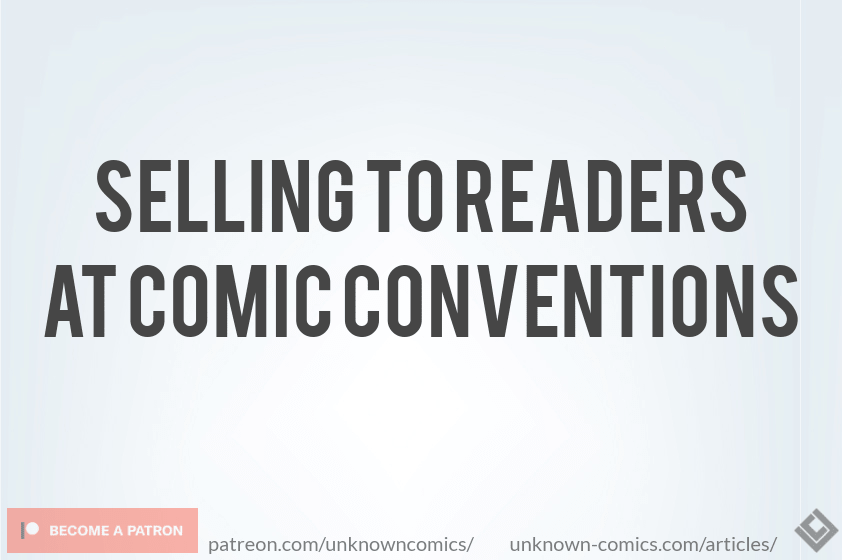In order to conclude my (surprisingly long) series about selling to readers, I felt it necessary to also talk about attending comic conventions.
(Sources Notice: Please keep in mind that Unknown Comics will at times use third party source material. Be sure to check the bottom of the article for the Sources button.)
This article will focus on the few things that you, the comic creator, can do at a comic convention in order to improve your chances of selling to comic readers.
Now, you’ll find at the very bottom of this article a button to open up the citations for this article. If you do do that you should be able to find out that a whole lot of what I plan on writing here actually comes from the works of Comfort Love and Adam Withers (check out their site, it’s awesome) and their book The Complete Guide To Self-Publishing Comics.
Trust me when I tell you that I can’t recommend a better book for new or established comic creators. This book is probably the most comprehensive resources available in your local bookstore (if not, be sure to look it up on Amazon).
Now, let’s begin with your table.
On Your Own Space… Or Table
Whether or not you’re a new comic creator you'll most likely be the kind that ends up reserving a table at a convention.
On this little space you’ll have access to two key marketing tools that you can’t possibly do without. Those are the backdrops and the tabletop.
Backdrops
At its simplest, a backdrop is a visual design that can represent something about yourself, your comic or your brand that those walking by your table can see.
I would strongly recommend including the following: cool art, your brand (if you got one... trust me, you got one), and your name.
This is going to be the first thing that convention-goers will see. Don’t miss out on the opportunity to get this right.
Tabletop
You’ll also have a table on which you can display your work. What you show here should be what you actually are planning on selling or promoting to convention-goers.
This can be anything from exclusive variant covers, trade paperbacks of your work, pinups, original art, individual issues or your work (I would recommend always carrying enough copies of your first few issues to attract new readers), and any merchandise you’re willing to carry with you.
Panels
I personally haven’t had the pleasure yet but attending a panel at comic conventions is a great way to get the attention of comic readers.
Getting their attention is the first step. The next is figuring out what you should talk about.
Typically panels focus on one particular topic. But convention-goers also like asking questions. Either way, I'm sure you can figure out how to bring up a lot of different topics organically.
One thing you should definitely do is share. Talk about your process, those you’ve worked with, where you get your inspiration, and those who’ve helped you get to where you have. Sharing things like this makes potential readers feel invested in your work and make them more likely to purchase your comics.
Like the article so far? Support the production of more articles like this one!
The Hotel Lobby
A little less known practice probably, but if you’ve gone to a convention away from home; be it a different city, state, or even country I would probably recommend you rent a room at a hotel ]. Preferably near where the comic convention is being held.
The main point to take away here is, don’t be afraid of the hotel lobby after the convention.
This can pay off huge. Two reasons why.
Reason Two
You won’t be alone, other creators will populate the lounge areas and the bars and will likely be talking shop with other people already. This can be a great place to network if you’re starting out and it can help get your name out there.
Reason One
You really won’t be alone. If you think that only those renting space on the convention floor will be staying at nearby hotels then you’re sorely mistaken.
Convention-goers from out of town will also be hanging around the same nearby hotels as you. Hanging around the same lounge areas and bars.
Don’t be afraid to stop and answer questions or to socialize. This is a great opportunity to get to know your potential readers and existing fanbase on a one to one basis.
Shoot the shit, take a selfie, give them your card if you got one (get one), don’t forget to tell them to come by your table on the next day if you can.
More importantly, be yourself. People like to get to know creators that they’re interested in. Don’t try to force yourself, be polite, and have fun.
Conclusion
As I said before, this is a very brief summary. These are a few topics I plan on discussing here on Unknown Comics. Selling to readers at comic conventions has a lot of different angles to cover, and this article barely scratched the surface.
I’ll most likely dive deeper into these topics a little later after I've found some creators that have attended conventions and that are willing to share their stories.
I hope this has helped give you an insight of the few things you can do if you are planning on selling to readers at comic conventions.
Sign Up For
The Unknown Times!
Content Updates
Website News
Recommended Reading
And More to Come!
*Once every two weeks!*
Liked the article? Become part of my Patreon Community!
About The Author

Phillip Allen
Writer, Editor, and Founder of Unknown Comics
Hello there! My name is Phillip Allen and I'm the writer, editor, and founder of Unknown Comics. I am an aspiring comic book creator. In an attempt to learn how to create my own comic I came to learn just how few reliable resources existed out there. From a few books and unhelpful websites I decided to focus my attention on researching and writing a resource for both myself and the rest of the comic creating industry. This website and and its content is the result of all of that hard work.
Love, Comfort, and Adam Withers. “7. Marketing.” The Complete Guide To Self-Publishing Comics, Watson-Guptill Publications, 2015, pp. 215–219.

